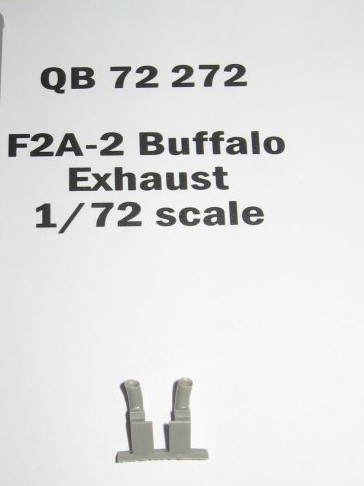Brewster F2A Exhaust Stacks
These accessories are produced by Quickboost, a resin-manufacturing firm that provides corrected components for discriminating modelers who want to get it right. Quickboost produces a large variety of corrected parts for aircraft kits in 1/72, 1/48, and 1/32 scale, and their website is very interesting to browse through. In this case, Hasegawa has taken a shortcut in their production process, not the first time this has happened. It reminds me of the old Lindberg kits many years ago that had standard propellers which were supposed to fit on many different kinds of airplanes. It didn’t work then, and still doesn’t today.
Hasegawa’s two issues of the Brewster F2A-1 and F2A-2 Buffalo, and this would include their kit of the Finnish Brewster 239, which is almost identical to the F2A-1, are the best kits available of these two aircraft. They are much better than the old Airfix and Matchbox kits, but everything usually can be improved upon, and these are no exception. The problem is that these two aircraft had different cowlings and engines, and the exhaust stacks were of different sizes and in different locations. This cowling difference represented in the kits, but not in the exhaust stacks. In fact, both kits include the same exhaust stacks on the same sprue, and the problem is that they are both way too small. The F2A-1 had smaller stacks located almost directly underneath the cowling, while the F2A-2’s stacks were higher up on the cowling, and much larger. Out of the box wouldn’t work in this case, so they really do need replacement.
Both QB F2A-1 and F2A-2 stacks are correct in size and shape with the ends hollowed out, thus saving you the trouble of drilling them out. They fit directly into the recessed holes provided in the cowlings, and will correct the error with little additional effort. There are virtually no instructions, but these are unnecessary for modelers of average skills. Just use the QB parts and put the kit parts in the spares bin.
Otherwise, these are fine kits, and with some of the other aftermarket details available, they can be made into contest winners. However, be careful with the F2A-1 kit, as the painting instructions have a glaring error that could lose a contest. Excellent Aeromaster decals are provided in the kit, but the instructions state to paint the top of the cowling of F2A-1, BuNo 1388, white. I know the photo they used as a reference, and it shows a cowling that looks white, but is actually lemon yellow.
However, anyone familiar with the Navy’s color coding system should know that in each squadron, 1-3 had red trim, 4-6 had white trim, 7-9 had true blue trim, 10-12 had black trim, 13-15 had willow green trim, and 16-18 had lemon yellow trim. Thus, 3-F-18 would actually have the lower half of the cowling painted lemon yellow, as the coding had the section leader with a fuselage stripe and cowling in the section color, while the second and third aircraft had no fuselage stripe and only the top and bottom halves of the cowlings in section colors. The white cowling would apply to 3-F-5, but the Bureau Number would be different. This lemon yellow color, incidentally, is not to be confused with the orange yellow finish on the upper surfaces of the wings.
Also, all aircraft in the squadron had the diagonal strips above the wings for aid in formation flying, and these should be lemon yellow also, with thin black outlines. So, even the best of them sometimes make an error, and only diligent research can detect these. These colorful schemes went out shortly before the outbreak of World War II, although they are still favorite color schemes of many modelers. For a nostalgia trip with authentic Navy color schemes watch the old Navy film, “Dive Bomber”. They certainly were colorful airplanes.
By the way, the Hasegawa F2A-2 kit can be used to build any of the Buffalo fighters used by the British, Dutch, and Australians in Southeast Asia at the beginning of the war by making only minor changes. Now if Hasegawa would come out with a Navy F2A-3 in 1/72 scale (and it could be done with an extra sprue or two) we’d have all of the F2A’s and Buffalos covered.
As for the Quickboost exhaust stacks, they are definitely worth getting. They’ll make a big improvement in your model for a modest investment. Think of it as your personal stimulus program. Highly recommended.
Thanks to Quickboost and John Noack for the review sample.



Comments
Add new comment
This site is protected by reCAPTCHA and the Google Privacy Policy and Terms of Service apply.
Similar Reviews